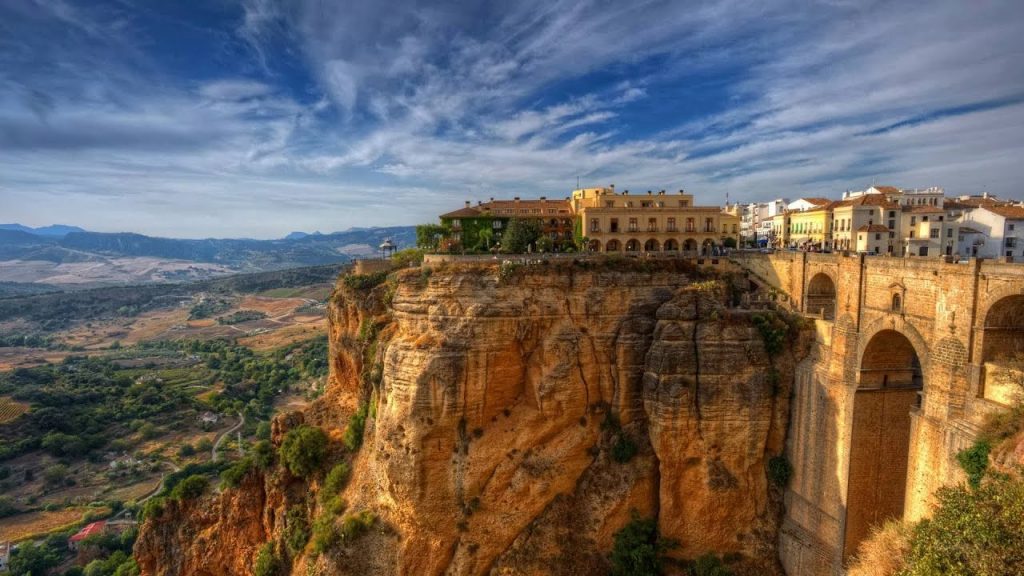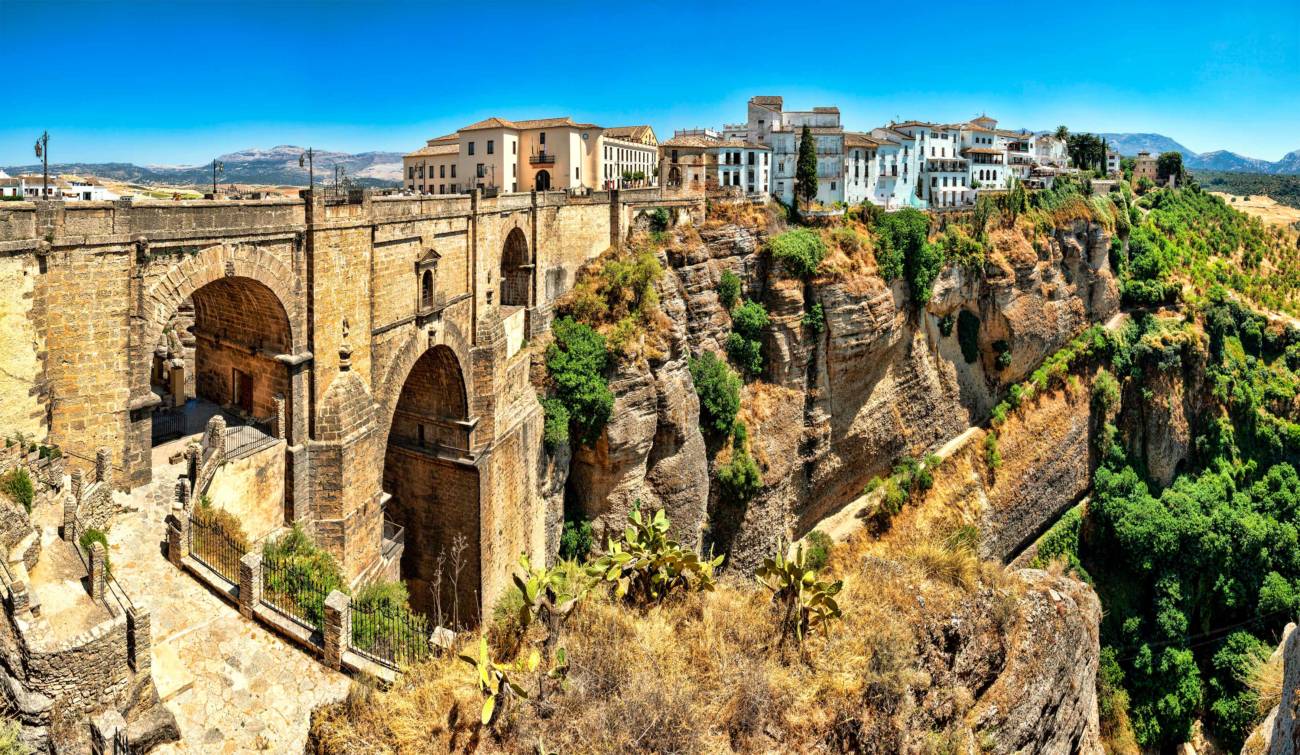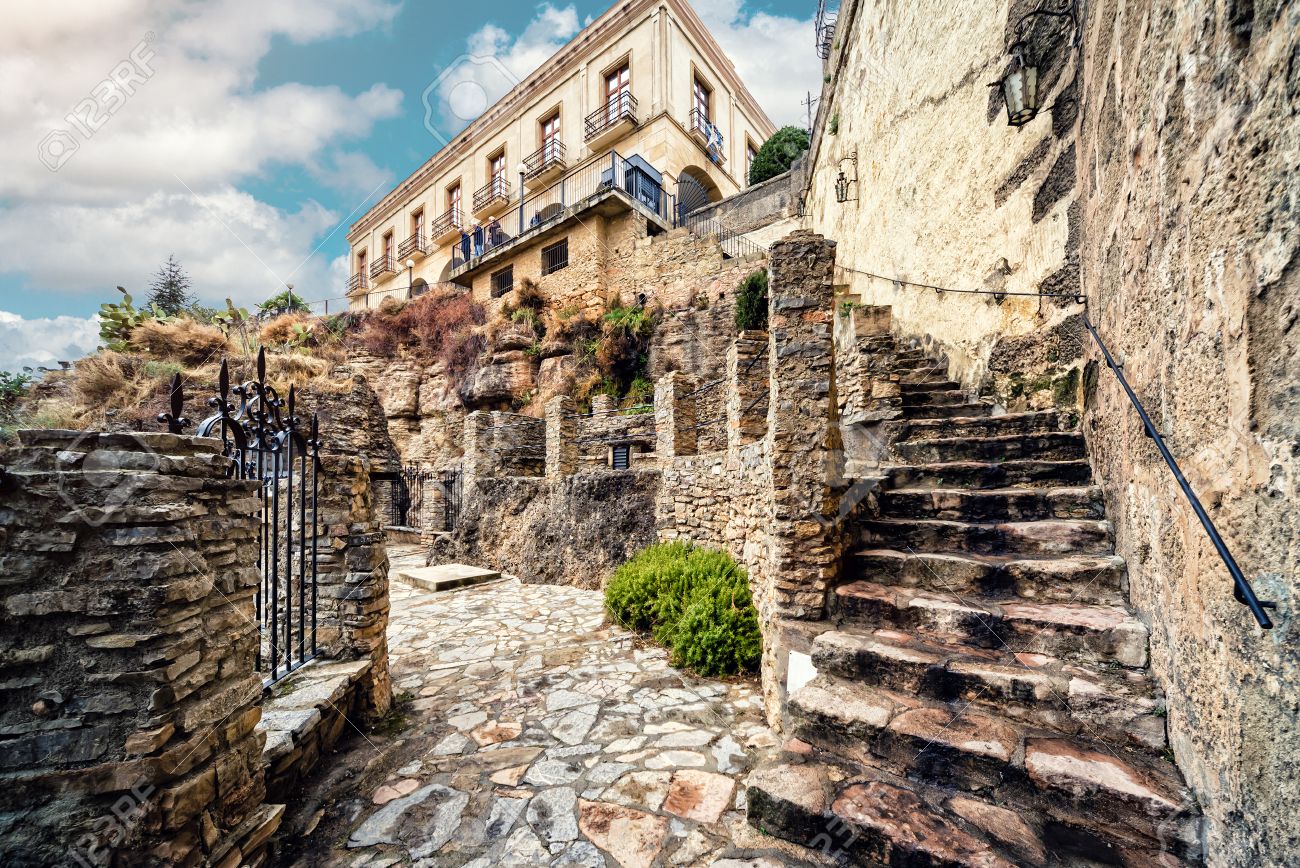
We totally get it, you just went off your plane and need to seek a transfer to Ronda, in this article you’ll find our services but also some information that can be useful for your vacation time.
Index
Culture
History of Ronda
Ronda is one of the oldest cities in Spain. Its origins go back to the Neolithic, according to the archaeological discoveries made in its old town.
However, the presence of man in these lands is much earlier.
Of her, they are good test a series of deposits in caves, between which it emphasizes the Cave of the Pileta, for being one of the best exponents of the rock art of the Paleolithic Andalusian.
During Recent Prehistory there would be a proliferation of settlements throughout the territory that, as far as remains are concerned, will be represented by one of its most relevant and monumental cultural manifestations.
Such as the megalithic necropolises: Dólmen del Chopo, from Encinas Borrachas, among others.
It will be at this time, then, when the two most important towns of the region, Acinipo and Ronda, are consolidated as well, although their respective periods of apogee will not occur until later; the first in Roman times and the second in medieval times.
Of the Roman occupation of the Peninsula, there are in our area numerous vestiges, among which are those discovered in the city of Ronda itself.
But, without a doubt, it is the archaeological site of the Roman city of Acinipo that is most important, given its state of preservation as well as some of the most emblematic elements of a classical city, such as the theatre.

Missing Acinipo, after the convulsive period that led to the fall of the Roman Empire, the centre of attention will go towards Ronda, which, although being a very small nucleus during the first Middle Ages, will be the protagonist of all the historical ups and downs since then. They met in this territory.
Of these, the one that stands out for its transcendence and for the cultural legacy that has left us and that is still perceptible in many of its manifestations (urbanism, gastronomy, traditions, farming systems, etc.), was the Islamic period.
It is at this time when Ronda is configured and consolidated as a city, becoming the capital of one of the Kuras (Provinces) in which it was divided al-Andalus (that of Takurunna) and, even, become an independent kingdom (the so-called kingdoms of taifas) after the disarticulation of the Cordovan Caliphate.
But the most significant role, and for which it is better known, will come with the Nasrid kingdom of Granada.
Since its proximity to the territories conquered by the Castilians, both the city and the region, in border enclave of special importance.
With the conquest of the city by the Catholic Monarchs, there will be profound economic and cultural transformations that even today can be seen in the physiognomy of the urban structure: an opening of previously nonexistent squares, widening of streets, etc.
But it will be the eighteenth century that marks, in this modern era, the definitive guidelines of the role that Ronda will have in the context of Andalusia.
It is at this time that the most significant and emblematic monuments of the aristocracy of that time and of the current Ronda are built: the Puente Nuevo and the Plaza de Toros.
From then on, and throughout the nineteenth century, the romantic image of the city is forged, as well as its Serrania, in which the world of banditry and bullfighting will make a profound impression on many famous travellers.
Both aspects have since become symbols of our culture and tradition. However, the cultural and traditional richness of Ronda is much broader and more diverse than that offered by this image, which, however pleasant, is still topical.
It is in this diversity that the current attractiveness of Ronda and its Serrania is based.

Monuments to visit
After getting to know where this town comes from… Getting your transfer to Ronda can make you wonder wich monuments are worth to visit.
Here’s a list of the places that you don’t want to miss!
El Puente Nuevo
Puente Nuevo is, together with the Bullring of the Real Maestranza de Caballería de Ronda, the symbol and soul of the city.
There were two major projects for the realization of this work.
The first of the year 1735, reigning Felipe V, which consisted of an arch of 35 meters in diameter, and whose works lasted only 8 months, but it proved fruitless because six years later it collapsed, causing the death of about 50 people.
A few years later the works began, specifically in 1751 and ended in May 1793, coinciding with the celebration of the Royal May Fair in Ronda.
In total, more than 40 years were invested, being the architect D. José Martín de Aldehuela, a native of the Teruel town of Manzanera, in charge of them.
Santa Maria la Mayor Church
According to the archaeological studies developed in the area, this church was located very close to the remains of a Paleochristian basilica of the 5th century AD.
Also, some historians go back to the Roman era in which it had the function of the temple. This last point has not yet been contrasted archaeologically.
In the same place was built later, under Islamic rule, the main mosque of the Medina.
Only the arch of the Mirhab and a piece of the wall of the same with atauric decoration, hidden behind the altarpiece of the altar of the tabernacle, is preserved.
The Catholic Kings, after the conquest of the city, ordered to build the temple in the place of the mosque, whose works began in 1485 and after many vicissitudes, were completed at the end of the seventeenth century.
The Gothic style is represented in its three naves.
Although the earthquake of 1580 destroyed part of the factory hiding the purity of the Gothic, it can still be seen in the free or attached columns and the warheads of the arches that support.
These, in turn, are supported on capitals run with vegetal decoration of cardinas and anthropomorphic.
Mondragón Palace
The Palace of Mondragón, also known as the Palace of the Marquis of Villasierra, is a magnificent architectural property, without a doubt the most significant civil monument in Ronda.
Legend has it that it was the residence of the great king Abbel Malik or Abomelic, son of the sultan of Morocco Abul Asan.
A few years after the death of Abomelic, the kingdom of Ronda became dependent on that of Granada, knowing that the last Muslim governor Hamet el Zegrí also resided in this palace.
It is difficult, without an archaeological exploration, to determine how this palace would be in the Muslim phase, although it can be guaranteed that it would be organized around the patio closest to the pit, with the current incorporated garden, not existing, of course, the current bay of the facade.
Walls and islamic doors
The location of Ronda on a rocky promontory has given it a marked strategic and defensive value throughout history.
In Muslim times, the Muslim Medina was located, clearly delimited both by the natural barrier that the gorge excavated by the Guadalevín and by the city walls itself.
Of the important preserved walled fence we should highlight the Almocábar gate located in the southern sector of the medina, built in the 13th century and restructured in the period of Charles V.
This door takes its name from the word “Al-maqabir”, cemetery, for being close to the main necropolis outside the walls, according to Islamic custom.
It was one of the main gates of access to the city and gave access to the Barrio Alto, currently the Holy Spirit and the Muslim medina.
In the middle of the sixteenth century, another access body was added to the front with a quadrangular plan and the main door with a crenellated Renaissance style, consisting of around arch in stone, on which there is a large royal shield supported by the imperial eagle.
Plaza de Toros
Well known for its history, because of its history and its architecture, because of its character and beauty, it is recognized as one of the oldest in Spain and one of the most monumental in existence.
It is not by chance, Ronda is considered one of the cradles of modern bullfighting, emerged in the eighteenth century, in a city where the tradition of chivalry was kept very alive to exist a corporation dedicated not to miss the equestrian art.
The needs of defence of the territory caused that Felipe II founded in 1.572 The Real Maestranza of Cavalry of Round, so that the necessary handling of the horses was maintained.
For this, this body dedicated a space of the city for equestrian exercises, among which, as is traditional in Spain since the Middle Ages, games of skill with bulls were included.
When in the eighteenth century the bullfighters on foot take over from the knights in the games with the bull, the family of Romeros emerges in Ronda, which for three generations brings together the most unique bullfighters of the time.
Among them, Pedro Romero (1754-1839), the most important figure of bullfighting, stood out above all. He retired after stopping more than 5000 bulls without receiving the slightest scratch.
His personality achieved that his office achieved social dignity and respect, by gathering value, dexterity, and aesthetic sense.
The bullfighting boom led the Real Maestranza de Caballería de Ronda to erect its famous square, a work attributed to Martín de Aldehuela, the same architect of the great Puente Nuevo Bridge on the Tajo de Ronda.

Restaurants & Food
What you would eat
But maybe after thinking about where you should go to walk around, you get to wonder where do you need to eat? So take your time while you are at your transfer to Ronda and read this tips.
In Ronda two of the fundamental ingredients for forging a quality gastronomy meet: a thousand-year-old cultural tradition that mixes the flavours, ingredients and techniques of many civilizations, and a natural environment that offers the best raw materials for the elaboration of recipes.
The Serranía de Ronda and its magnificent climate are the ideal enclave for the cultivation of first-rate vegetables and legumes, which serve to cook the exquisite stews and rondeños stews.
The mushrooms are one of the symbols of this area of the province of Malaga. Its forests house a great variety of this delicacy: wild mushroom, morel, chantarella, ticket, etc.
Nature from which other ideal products are born for any preparation: wild asparagus, tagarninas and various fresh vegetables.
Without forgetting the famous chestnut of the Genal Valley, which gives rise to rich recipes, but it is worth eating them naturally.
If there is one thing that really stands out in the cuisine of Ronda are its game meats.
From them are born sausages of own creation such as blood sausages or another type of chacina. For those who want to know more about hunting in the area, there is a Hunting Museum in the city that you can visit throughout the year.
Of all the typical dishes, one of the most requested is oxtail.
In the restaurant Abades Ronda they prepare it in a traditional way, stewed and accompanied by some delicious vegetables and potatoes. Delicious culinary proposal that you should not miss if you visit Ronda.
Social & Activities
Trail routes in Ronda
The Serrania de Ronda has a great natural richness and is the favourite destination of many hikers. Moreover, the Serranía de Ronda is one of the Andalusian regions with the most complex mountains, streams, rock formations and slopes in general. That’s why here we present you several hiking routes that you can do in Ronda:
Ronda-Molinos del Tajo
This route passes through the area outside the city of Ronda. La Hoya del Tajo, has that name because of its boiler shape. It is a depression at the foot of the famous Tajo de Ronda through which the Guadalevín River passes.
It is worth noting that it is a circular route with a length of 10 kilometres with a medium difficulty. The route begins at the viewpoints of the Hoya del Tajo in the Doctor Vázquez district. And the route stands out because it passes by a forest of pines and fruit trees and by the ruins of the mills of the Tajo. You will not cease to be surprised by its impressive views.
Route of the Tajo del Abanico, from Ronda to Benaoján
The route from Ronda to Benaoján via the Tajo del Abanico is a site of great geological wealth. The route begins in Ronda and continues through the Colada del Camino de Ronda a Cortes, which we leave behind, to contemplate the walls of the Tajo del Abanico, and then take the path to Benaoján.
This is a 14 km linear route of medium difficulty that lasts about 5 hours. The path runs through areas of abundant vegetation and also has impressive views of the karstic landscape of the Libar Massif. Besides, the rock of the Tajo del Abanico is a composition of sandstone with limestone called “Molasa”.
BOOK YOUR TRANSFER TO RONDA HERE!
You can book your transfer to Ronda in the link bellow, also you can get more information regarding the city and what to do.

